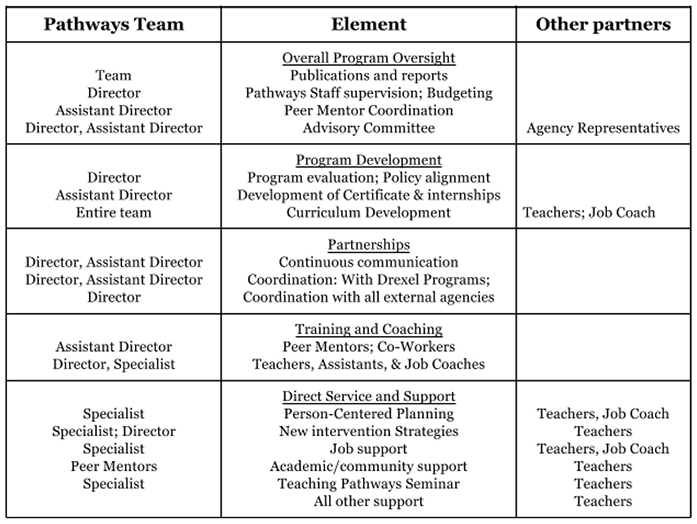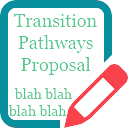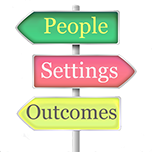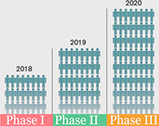Supplemental Materials: Investing in program development
Roles and Responsibilities of Team Members
November 30, 2016
Before I outline below the full range of responsibilities specifically related the Transition Pathways initiative, for staff hired by Pathways and those hired by community partners, it is helpful to outline patterns in the distribution of effort across Transition Pathways staff relative to those of our community partners (additional details regarding each of the underlined categories is provided under Types of duties and responsibilities).
- A core principle of the Transition Pathways initiative is that program innovation that leads to the improvement or expansion of services is impossible without an initial significant investment in a phase of program development. This phase typically includes the development and implementation of related activities around new training and an increased role for advocacy.
- Especially in the case of programs for people on the autism spectrum, this also includes new or renewed partnerships. Transition Pathways staff focus the majority of their effort on program development, training, advocacy, and partnerships.
-
This plan envisions the majority of direct services being delivered by partner schools and service providers, with two exceptions:
- The introduction of new approaches to delivering specific services, in which case it is helpful to have such services initially delivered by Pathways specialists during a training phase, until fidelity is established, and
- The introduction of new supports that can be sustained through public funding or other means (like peer mentors for the College Pathway).
In the sections below, I assigned specific leadership roles to different staff for different components, summarized in the accompanying figure, using Year 1 of the College Pathways as the example. The allocation of responsibilities would also be used to develop supplemental sections of the Job Descriptions for Pathways staff. Every staff member hired via Pathways, and other key personnel from partner agencies, would find a place in this chart.

The only exception was the role of advocacy, and the place of the Advocate Consultant. Advocacy must be woven into each of the components listed below. In the long-term, I had hoped to more clearly define elements of this components, and the people and steps needed to attain it. In the short-term, I committed to involve the Advocate Coach, and other self-advocates engaged in an advisory capacity wherever possible.
Program Development: Types and allocation of duties and responsibilities
Overall Program Oversight
Pathways Staff supervision: Staff involved in Pathways must themselves by hired, supervised, and evaluated as needed. That task must be assumed by the Director
Peer Mentor Coordination: Peer Mentors may play a central role in key phases of specific pathways, for a variety of important reasons. In the proposal development process, we generated projections of the number of peer mentors needed, based on assumptions about the number of hours they might be available, whether they were paid and unpaid, and so on. We expect that some effort will be needed to coordinate these efforts: to initiate match peers with Pathways students, to help them to manage their hours if they are paid, and so on. Much of this work can be assumed by an administrative assistant, with support by a Pathways Specialist or Assistant Director (note that the training and supervision of peer mentors is described elsewhere).
Advisory Committee: The input and stakeholders and advocates will be essential to developing this complex program that addresses so many different kinds of needs, across so many different kinds of settings, with so many different partners. Some of this is captured under Partnerships, and the rest via an Advisory Committee. We anticipate an advisory committee of 12-15 members, that will include advocates, and representatives from Drexel and partner programs, and that will meet twice annually. We also expect a smaller steering committee of 5-6 members that will participate in monthly conference calls. The Administrative Assistant can help to coordinate these meetings and calls, and to keep notes but the meetings themselves will require the leadership of the Director
Budget management: Although we expect a limited range of expenses, we nonetheless need to establish procedures to tracking expenditures. Some of the paperwork can be completed with by the Administrative Assistant, but accountability will rest with the Assistant Director or Director
Publications and reports: In addition to the annual reports to be prepared for the foundation, our efforts to disseminate the lessons learned from Transition Pathways will depend largely on other kinds of publication (articles in journal, chapters in books, blogs, presentations at local venues or professional conferences). We expect that most of these will be authored under the leadership of the Director, with the rest authored by the Assistant Director or Pathways Specialist to the extent that these contribute to their professional goals. .
Program Development
Program evaluation: We will need to develop overall goals for Transition Pathways, and build in mechanisms to monitor progress towards these goals. These certainly include broad goals established at the program level (number of students enrolled, number of placements, and so on), but over time may include data derived from the aggregate of individual student progress (increased skills related to work, self-advocacy, and so on). The Director will lead this process, with input from other Pathways professionals, and from the Advisory Board. It may be advantageous to enlist other expert support . We also expect that this may be a need for partner organizations, and so we expect that the Director will explore opportunities to offer this support, especially if this helps to align aggregate goals across organizations.
Policy Alignment: Policy review is critical to sustainability. Policies here include those related to funding sources, eligibility criteria, approved services, accommodations, and the coordination of all of these across agencies. We expect that this will evolve from alignment of policies to ensure coordination of services across current partners for the current cohort (perhaps captured in Memoranda of Understanding with partner organizations), to replication and expansion of policies in other other organizations to support expansion. This policy review will be lead by the Director, in collaboration with partner agencies.
Transition Pathways Certificate: The development of the Transition Pathways certificate is a critical step towards embedding many of the activities (and their associated supports) into the Drexel Infrastructure. The includes the certificate itself (courses, internships, and so on), especially as it informs other processes (like admissions, fees, and so on). The development and adaptation of the Transition Pathways certificate will the led by the Assistant Director. Note that we are distinguishing here the development of the certificate from the overall curriculum (described below) and the actual teaching of courses (described in a later section)
Curriculum Development: Curriculum development here includes specific components (like the Transition Pathways courses related to independence, work, community, and lifelong learning skills in Year 1 and 2), and cross-cutting components (like long-term, person-centered planning). These activities are separate from the actual teaching of these courses, captured in a later section. We expect that different Pathways staff will be designated to assume leadership of different components, in collaboration with staff from partner programs, and with help from other experts engaged as consultants as needed.
Development of internships: Of the four tracks in Transition Pathways, employment is clearly the most important. The success of our Employment track depends on the creation of internships, initially at Drexel, and later with our Co-op partners. The development of internship placements is also the stepping stone to identifying opportunities for permanent employment. We expect that different Pathways staff will be designated to assume leadership of different components, in collaboration with staff from partner programs, and with help from other experts engaged as consultants as needed.
Partnerships
Programs like Transition Pathways that depend on leveraging resources and expertise from multiple partners require a specific plan to identify, develop, and maintain those relationships. These relationships existing at multiple levels within the organization, and with external organizations that have a role in services, training, research, and policy. The partnerships are needed to establish a common agenda, ensure continuous communication, and establish a mutually reinforcing plan of action. These partnerships can coordinate services for individuals or entire programs across agencies, and at the state level to coordinate policies to braid services and funding. Partnerships within Drexel can coordinate efforts across departments, with the eventual goal of having different departments directly administer specific aspects of the program.
Coordination with Drexel Programs: There are many different departments and programs within Drexel that will play a minor or a major role with Transition Pathways (some of these are listed in a draft communication plan developed separately). The Assistant Director and Director will work together to initiate these partnerships, and the Assistant Director will maintain the majority of these partnerships once established.
Coordination with Partners outside of Drexel: Key partners outside of Drexel include the those involved in the day-to-day operation of the program (Philadelphia School District, Community Integrated Services), those involved in potentially funding elements of the program (DREAM Partnership, Office of Vocational Rehabilitation, Office of Developmental Programs, Bureau of Special Education), and other model programs we might seek guidance from. These will be initiated and managed by the Director.
Continuous communication: While we all strive for clear correspondence and timely follow-up, this becomes even more important for projects that seek to achieve collective impact, like Transition Pathways. In their leadership roles, the Director and Assistant Director dedicate time each day to initiate communication to coordinate with program partners, and to ensure follow-through. This can vary from emails clarifying small program details to outlining timelines for development of critical components to co-creating documents supporting program implementation.
Training and Coaching
As described elsewhere (Doehring, 2013), research and policy translates into improved services and outcomes primarily through training and coaching. This training must be carefully designed in given the role of different individuals (peers, co-workers, program leaders, direct service professionals) in the life of the adult with ASD. New training must also complement the training these persons may have already received, and may receive on an ongoing basis from the departments or agencies within which they work. Efforts to raise awareness amongst other Drexel faculty who interact with students on the autism spectrum is an important activity not discussed here, because it is likely to be addressed via a Neurodiversity curriculum currently in development.
Peer Mentors: Peer mentors are the natural support for campus-based student life. Various types of training (formal course, informal workshops, informal one-to-one guidance), of peer mentors based at Drexel has been provided on the past, though not in a consistent manner from year to year. Moreover, this training has been provided to students competing traditional degree programs, not to non-matriculating students who we expect to enroll in Transition Pathways. We expect that we will need to invest time and effort into redesigning a training curriculum better suited to Transition Pathways, and that ensures consistent and sustainable implementation. The Assistant Director will lead these efforts, in collaboration with the Director.
Co-Workers at internship sites: Co-workers constitute the most natural support at the internship site, and on the job. We expect to develop or import modules for raising awareness about autism amongst co-workers. The Assistant Director will lead these efforts, in collaboration with the Director.
Teachers, Assistants, and Job Coaches: As employees of our partner agencies, teachers and job coaches likely receive general training in persons with disabilities. Licensure requirements of teachers also ensure some level of general training in goal setting, case management, teaching and behavior management strategies. Assistants receive minimal training in intellectual disabilities, let alone ASD. All of these individuals will need training activities tailored to their role, and that complements the training they may have already received. Given that the most powerful training is case-based, we expect to devoted a greater proportion of services to individual feedback and coaching. This curriculum will be developed by the Director in consultation with Pathways Specialists, the training itself delivered by the Director and Pathways Specialists, and the individual coaching delivered by the Pathways Specialists.
Direct Services: Types and allocation of duties and responsibilities
The Transition Pathways Program Incubator model deliberately draws almost entirely upon existing levels of services and supports, and thus build in accessibility, sustainability, and replicability from the start. Based on a formula established in collaboration with the Philadelphia School District, one teacher and one assistant will be assigned for every cohort of student. We expect that one full-time professional staff would be assigned by Community Integrated Services for every 16 students. Thus, 2 teachers, 2 assistants, and one other professional staff would be allocated by community partners for the initial phase of the initiative, when 16 students are enrolled in each cohort. This would double In the second phase of the initiative, with the additional enrollment of 16 students/year. We are currently in negotiation with the state agencies (the Office of Developmental Programs, and the Office of Vocational Rehabilitation) to determined the funding rate for support staff allocated through our adult services partners (Community Integrated Services).
The sections outlined below reference only those elements of Direct Services that are not currently being provided, or those elements for which we anticipate additional levels of support provided during a start-up phase can both improve student outcomes AND provide valuable professional development opportunities.
Person-Centered Planning and Advising: To date, we have identified no single professional or agency that assumes overall leadership for long-term planning once adults exit high school. Even transition plans prepared prior to graduation often lack key elements. Creating coordination across the different areas or tracks in Pathways, and that bridges the transition from high school, requires the development of a new type and level of planning. We anticipate adopting one of the currently accepted person-centered planning paradigms to structure plans and biannual planning meetings, and to utilize Pathways Specialists to lead this process in collaboration with teachers, job coaches, and case coordinators from partner agencies. We will also supplement periodic planning with more frequent meetings with an “advisor” designated for each student, to track progress towards the goals identified in the plan. We expect that the Director, Assistant Director, and Pathways Specialist will each assume the role of an advisor.
New Intervention Strategies: We expect that we will pilot at least one new programmatic element each year that involves direct intervention with students. For example, we have discussed the merits of developing and implementing a self-advocacy curriculum. in this case, we anticipate relying on Pathways Specialists and the Director, in collaboration with identified experts, to lead the development of a plan to introduce and integrate a self-advocacy curriculum.
Job support: Preliminary inquiries suggest that there is a lack of capacity and/or specialized training for job coaches. At the same time, success from the start is important to develop and sustain enthusiasm among internships created at Drexel. We believe there is great value to investing some additional resources into individualized job coaching, at least in the first year or two of the program. We will accomplish this by pairing Pathways Specialists with job coaches provided by partner agencies.
Academic/community support: Given our goal of demonstrating the leadership role played by a university in creating new opportunities for adults on their campus, it makes sense to integrate peer mentors into those activities unique to university. We expect that this will include support in completing assignments for courses, and support to become involved in university clubs and activities.
Teaching Pathways Seminar: The Pathways Seminar draw as much as possible on methods and content school district teachers already use. Nonetheless, we expect that there may be other adjustments to content and methods given the university environment. To this end, we expect that the Pathways Seminar will be co-taught by the school district teacher and the Pathways Specialist for at least the first two years.









